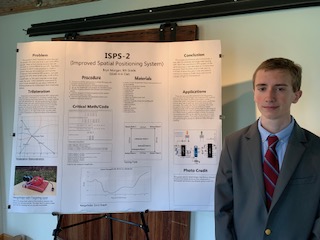ISPS-2 (Improved Spatial Positioning System)
Is there a GPS-like device on a small scale that is both inexpensive and accurate?
Student
Bryn Morgan
School
West Geauga High School
Supporting files
science-fair-report.pdf
The purpose of this project was to continue to explore whether it was possible to create a GPS-like device on a small scale that was both inexpensive and accurate. This project uses the same idea as GPS, called trilateration, where the location of an unknown point can be determined through that unknown point’s distance from a series of known points. This project is a continuation of a project that I worked on last year, with my goal this year being getting the system to work on a larger scale, and to experiment with other methods of measuring distance than were used last year. To accomplish this project, I used the previously stated idea of
trilateration (the equations of which were solved through a program I wrote), along with a laser rangefinder and a 50’x50’ testing area. In addition to this large scale testing, I also experimented with using sound as a measuring device instead of light by researching and soldering a circuit board that was able to use speakers and receivers to find distance. I was able to achieve a high level of accuracy, with an error of about 4 inches in a 50 by 50 foot area.
This project has many potential applications, including abilities that even the most expensive GPS receivers have. This includes the ability to track location while indoors, much more easily get location relative to nearby objects, and get an object’s location with much greater accuracy at a lower price. This project ended up working quite well, and was able to check all of the boxes that I had wanted. It also has a variety of different possible applications, one of the most interesting of which is its possible use in agriculture. Already, GPS is being used by farmers to help plant and maintain crops accurately, but this system has the potential to be as accurate, or even more accurate than existing systems. In addition, this system is much less expensive, my setup cost around 1/10th of a traditional system (only about $300 compared to a ~$3000 GPS system). So, in summary, my system has the potential to be very important to agriculture now, and in years to come.
